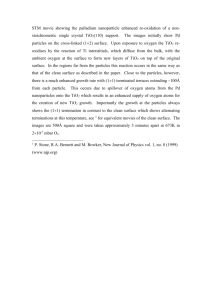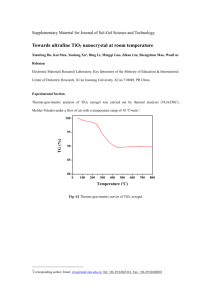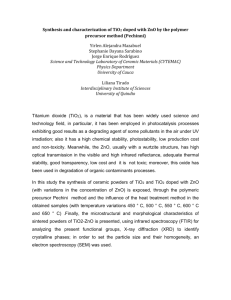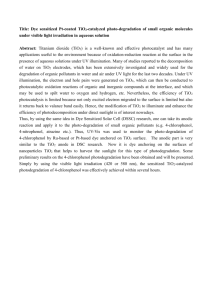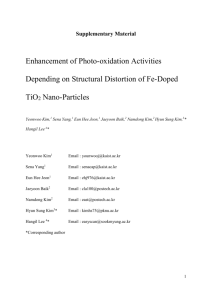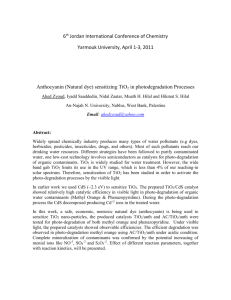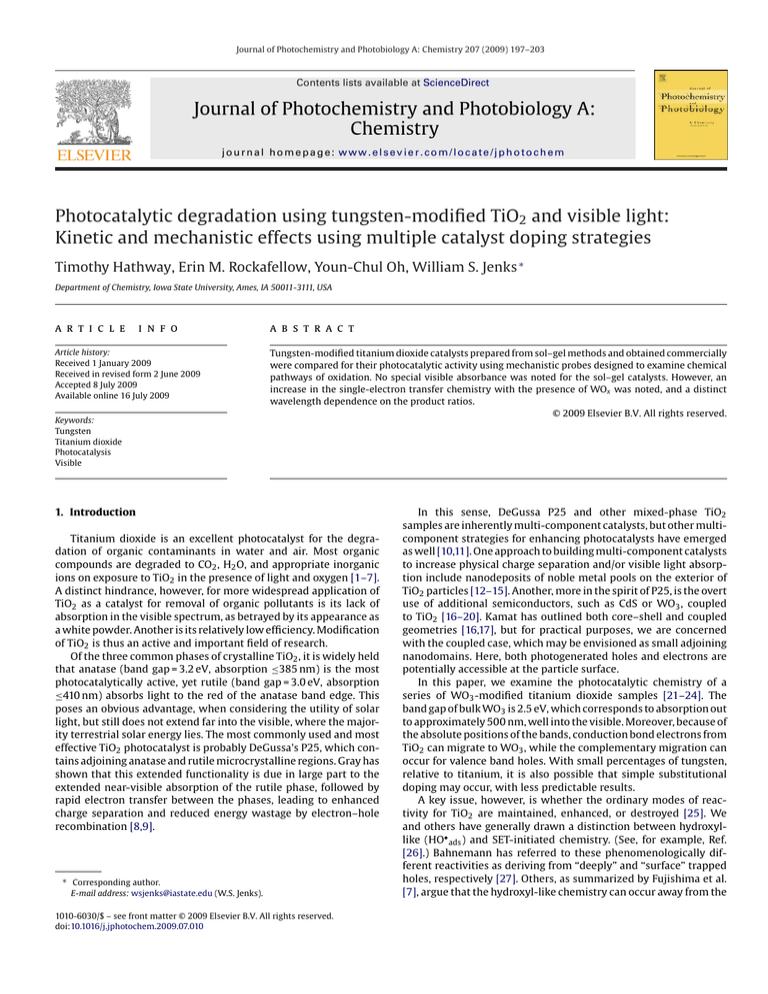
Journal of Photochemistry and Photobiology A: Chemistry 207 (2009) 197–203
Contents lists available at ScienceDirect
Journal of Photochemistry and Photobiology A:
Chemistry
journal homepage: www.elsevier.com/locate/jphotochem
Photocatalytic degradation using tungsten-modified TiO2 and visible light:
Kinetic and mechanistic effects using multiple catalyst doping strategies
Timothy Hathway, Erin M. Rockafellow, Youn-Chul Oh, William S. Jenks ∗
Department of Chemistry, Iowa State University, Ames, IA 50011-3111, USA
a r t i c l e
i n f o
Article history:
Received 1 January 2009
Received in revised form 2 June 2009
Accepted 8 July 2009
Available online 16 July 2009
Keywords:
Tungsten
Titanium dioxide
Photocatalysis
Visible
a b s t r a c t
Tungsten-modified titanium dioxide catalysts prepared from sol–gel methods and obtained commercially
were compared for their photocatalytic activity using mechanistic probes designed to examine chemical
pathways of oxidation. No special visible absorbance was noted for the sol–gel catalysts. However, an
increase in the single-electron transfer chemistry with the presence of WOx was noted, and a distinct
wavelength dependence on the product ratios.
© 2009 Elsevier B.V. All rights reserved.
1. Introduction
Titanium dioxide is an excellent photocatalyst for the degradation of organic contaminants in water and air. Most organic
compounds are degraded to CO2 , H2 O, and appropriate inorganic
ions on exposure to TiO2 in the presence of light and oxygen [1–7].
A distinct hindrance, however, for more widespread application of
TiO2 as a catalyst for removal of organic pollutants is its lack of
absorption in the visible spectrum, as betrayed by its appearance as
a white powder. Another is its relatively low efficiency. Modification
of TiO2 is thus an active and important field of research.
Of the three common phases of crystalline TiO2 , it is widely held
that anatase (band gap = 3.2 eV, absorption ≤385 nm) is the most
photocatalytically active, yet rutile (band gap = 3.0 eV, absorption
≤410 nm) absorbs light to the red of the anatase band edge. This
poses an obvious advantage, when considering the utility of solar
light, but still does not extend far into the visible, where the majority terrestrial solar energy lies. The most commonly used and most
effective TiO2 photocatalyst is probably DeGussa’s P25, which contains adjoining anatase and rutile microcrystalline regions. Gray has
shown that this extended functionality is due in large part to the
extended near-visible absorption of the rutile phase, followed by
rapid electron transfer between the phases, leading to enhanced
charge separation and reduced energy wastage by electron–hole
recombination [8,9].
∗ Corresponding author.
E-mail address: wsjenks@iastate.edu (W.S. Jenks).
1010-6030/$ – see front matter © 2009 Elsevier B.V. All rights reserved.
doi:10.1016/j.jphotochem.2009.07.010
In this sense, DeGussa P25 and other mixed-phase TiO2
samples are inherently multi-component catalysts, but other multicomponent strategies for enhancing photocatalysts have emerged
as well [10,11]. One approach to building multi-component catalysts
to increase physical charge separation and/or visible light absorption include nanodeposits of noble metal pools on the exterior of
TiO2 particles [12–15]. Another, more in the spirit of P25, is the overt
use of additional semiconductors, such as CdS or WO3 , coupled
to TiO2 [16–20]. Kamat has outlined both core–shell and coupled
geometries [16,17], but for practical purposes, we are concerned
with the coupled case, which may be envisioned as small adjoining
nanodomains. Here, both photogenerated holes and electrons are
potentially accessible at the particle surface.
In this paper, we examine the photocatalytic chemistry of a
series of WO3 -modified titanium dioxide samples [21–24]. The
band gap of bulk WO3 is 2.5 eV, which corresponds to absorption out
to approximately 500 nm, well into the visible. Moreover, because of
the absolute positions of the bands, conduction bond electrons from
TiO2 can migrate to WO3 , while the complementary migration can
occur for valence band holes. With small percentages of tungsten,
relative to titanium, it is also possible that simple substitutional
doping may occur, with less predictable results.
A key issue, however, is whether the ordinary modes of reactivity for TiO2 are maintained, enhanced, or destroyed [25]. We
and others have generally drawn a distinction between hydroxyllike (HO• ads ) and SET-initiated chemistry. (See, for example, Ref.
[26].) Bahnemann has referred to these phenomenologically different reactivities as deriving from “deeply” and “surface” trapped
holes, respectively [27]. Others, as summarized by Fujishima et al.
[7], argue that the hydroxyl-like chemistry can occur away from the
198
T. Hathway et al. / Journal of Photochemistry and Photobiology A: Chemistry 207 (2009) 197–203
particle surface, indicative of a diffusible intermediate (presumably
HO• itself). Regardless of the claims of true action-at-a-distance, we
have argued that SET chemistry has a more stringent requirement
for pre-adsorption to the catalyst and shown this to be the case for
both oxidative and reductive SET reactions [26,28].
In principle, if reactivity in WOx -modified TiO2 derives from
the oxidative reactivity of holes residing in TiO2 alone (surface or
“deep”), then both the typical hydroxyl-like and single-electron
transfer initiated chemistry ought still occur, assuming the reactivity is still dominated by adsorption on TiO2 sites. The valence band
for bulk WO3 is at a higher potential than for TiO2 , which could
result in hole trapping concentrated on these sites, which might, in
turn, be observable in the oxidative behavior. There is also a possibility of true wavelength dependence of the chemistry because of
the dopant, depending on the dynamics of hole trapping vs. substrate oxidation. However, if isolated WOx sites are dilute within
the TiO2 matrix, the effects are harder to predict.
There are multiple methods of making WOx -modified TiO2 ,
including an incipient wetness method, in which TiO2 is at least
partially coated with WOx from solution deposition, and sol–gel
methods, in which the tungsten is coprecipitated with the titanium
and is presumably distributed throughout the catalyst. (We will use
the term WOx –TiO2 below to mean tungsten-modified TiO2 in the
most general sense, and will be more precise when referring to
specific preparations.)
We examine the oxidative chemistry of two sets of catalysts.
First, we compare two commercial catalysts: PC50 and DT52 from
Millenium chemicals. The latter of these is derived by treatment of
the former to coat it with WOx by an incipient wetness method,
such as that described by Do et al. [21]. This process presumably
results in segregated regions of WOx on the TiO2 particle. A second
series is a set of sol–gel-prepared WOx –TiO2 catalysts with 0–5%
tungsten, prepared according to the method of Li et al. [23]. By
contrast, there is no evidence to suggest anything but a randomly
formed mixed oxide for these materials. Rather than evaluate the
chemistry by disappearance of a dye such as methylene blue [29],
we use chemical probes originally proposed by Ranchella et al. [30]
and Pichat and co-workers [31,32] that provide more detailed information regarding the chemical mechanisms of oxidation of these
catalysts, revealing pathways through product analysis.
2. Experimental
2.1. General materials
1-p-Anisylneopentanol (AN) and the oxidized products of its
degradation were synthesized and characterized as published previously [25]. Quinoline and its major oxidized products were
obtained from Aldrich. Distilled water was purified from a Millipore
MilliQ UV system and had a resistivity of ≥18 M cm−1 . Commercial titania samples were PC50 and DT52 obtained from Millennium
Chemical.
2.2. Preparation of WOx –TiO2 catalysts
WOx –TiO2 was prepared by a sol–gel method based closely on
that of Li et al. [23]. A TiO2 transparent sol was prepared by combining 17.5 g Ti(O-nBu)4 , 120 mL ethanol, 15 mL acetic acid, and
5 mL de-ionized water. The mixture was aged for 1 day, stirring at
room temperature. To this sol was added dropwise added 60 mL of
aqueous solution of containing 4.56 g of ammonium paratungstate
((NH4 )10 W12 O41 , F.W. = 3042.55) under vigorous stirring over 2 h
until WOx –TiO2 (3 mol% WOx to TiO2 ) gel is formed. Similarly, 0%,
1%, and 5% WOx –TiO2 samples were prepared by using appropriate
amounts of ammonium paratungstate. Ammonium tungstate was
also used in the same way to prepare a 3% WOx –TiO2 gel with a
different W source; no detectable difference was found between
materials made from the two precursors.
The WOx –TiO2 gels were aged 2 days with vigorous stirring, then
1 day undisturbed followed by 1 more day with vigorous stirring.
The WOx –TiO2 gels were then dried with a rotary evaporator at
358 K. As the gels dried, they shrunk and coated the surface of their
flasks, eventually forming powders. After drying, the samples were
ground for 8 min in an agate ball mill.
Sintering was then carried out in porcelain crucibles. The furnace
was heated at a moderate rate (10 K/min) to ensure that ejection of
the volatiles did not discharge powder from the crucibles. The furnace was allowed to reach 923 K, which then stayed constant for 2 h.
A calibrated thermocouple was placed in the center of the cluster of
crucibles to continuously monitor the temperature at the location
of the samples. The furnace was then allowed to cool down over the
course of 2 h. The cooled powders were immediately transferred to
storage vials.
2.3. Catalyst characterization
Powder X-ray diffraction (XRD) measurements were carried out
at room temperature using a diffractometer with Cu K␣ radiation.
An accelerating voltage of 40 kV and an emission current of 30 mA
were used.
X-ray photoelectron spectroscopy (XPS) was performed with a
multi-technique spectrometer employing monochromatized Al K␣
radiation. The instrumental Gaussian full-width at half maximum
(GFWHM), which characterizes the resolution, was 0.65 eV for the
Al source. The take-off angle was fixed at 45◦ and the X-ray source
was run at 14 kV and 250 W. The emitted photoelectrons were sampled from a 1 mm2 area. The XPS energy scale was calibrated against
Au 4f7/2 and Ag 3d5/2 peaks at 84.0 and 368.27 eV, respectively. The
sample was mounted on an indium foil for XPS analysis and placed
in the XPS chamber, whose base pressure was about 3 × 10−10 Torr.
Temperature was measured with a Type K thermocouple.
Particles were examined by scanning electron microscopy (SEM)
using a variable pressure scanning electron microscope with 20 kV
accelerating voltage and ∼0.5 nA of beam current for imaging in
25 mm working distance. SEM-EDX analyses were performed to
check for segregation of the tungsten. A high-purity Ge lightelement X-ray detector was employed and the take-off angle was
fixed at 30◦ .
2.4. Suspensions and photolyses
Photocatalytic degradations were carried out as described previously [25,33]. Broadly emitting fluorescent lamps centered at
419 nm (roughly 390–500 nm total range) or 350 nm (roughly
320–380 nm) were used. The spectral distributions are available in the supporting information. Ferrioxalate actinometry was
employed in order to compare the rates between UV and visible
reactions [34,35]. Initial conditions were 300 M AN or 150 M Q
in water containing 1 g/L catalyst and all solutions were purged with
O2 . The pH was controlled throughout the kinetic run reactions by
careful addition of aqueous NaOH as necessary. The reported initial
degradation rates were normalized for total lamp flux by means of
potassium ferrioxalate actinometry.
3. Results
3.1. Catalyst characterization
Based on SEM analysis, the average particle size of the sintered, tungstated catalysts was in the range of 100 nm to 3 m,
which is much larger than P25 particles (Fig. 1d). Ball-milling was
T. Hathway et al. / Journal of Photochemistry and Photobiology A: Chemistry 207 (2009) 197–203
199
Fig. 1. Characterization of sol–gel catalysts. (a) Powder XRD patterns; (b) detail of XP spectrum of 3% WOx –TiO2 ; (c) diffuse reflectance UV–vis spectra; (d and e) SEM images
of P25 (d) and 5% WOx –TiO2 after milling (e) on the same scale.
used to successfully grind the particles into the 20 nm regime
(Fig. 2e), yielding both smaller particles and a tighter distribution
of sizes.
As was noted by Li et al. [23], addition of WOx to the sol–gel
preparation of TiO2 inhibited the conversion of anatase to rutile
on annealing at 923 K. Studies of similar substitutionally W-doped
titania catalysts show that W6+ exists in distorted octahedra. These
cause long-range distortions that lead to anatase being favored
over rutile up to temperatures higher than for undoped catalysts
[36].
Fig. 1a shows the powder XRD of P25 (anatase and rutile), the
undoped catalyst (0% WOx –TiO2 , mainly rutile), and the doped
materials (mainly anatase). Using the Scherrer equation, average
crystallite sizes were found to be 15 nm, 18 nm, 23 nm, 28 nm, and
Fig. 2. SEM-EDX images of the 3% WOx catalyst on the same scale as Fig. 1d and e. Clockwise from the top left: overall SEM, C signal, O signal, background, W signal, Ti signal.
200
T. Hathway et al. / Journal of Photochemistry and Photobiology A: Chemistry 207 (2009) 197–203
19 nm for 5% WOx , 3% WOx , 1% WOx , 0% WOx , and DeGussa P25,
respectively.
XPS was used to determine the oxidation state of W near the
surface of the catalysts. Fig. 2b shows the underlying Ti 3p signal
at 36.6 eV for the undoped sample. For the 3% WOx –TiO2 sample,
the signal for the W6+ 4f7/2 –4f5/2 doublet at 36.0 eV is an inherently
stronger peak and dominates the spectrum, with the apparent loss
of resolution between the double peaks being due to the underlying Ti signal. Small contributions of other states are possible due
to broad peaks [37]. Data from the XPS were also used to confirm
the overall doping percentage (1.87% W, 32.80% Ti, remainder O,
corresponding to 3 mol% W, relative to Ti, in TiO2 ).
Diffuse reflectance UV–visible spectrophotometry (Fig. 2c)
shows that there was not a dramatic shift in the absorption spectra of the catalysts outside of what is predictable from the XRD
data. P25 shows the typical band edge of TiO2 , with a slight tail into
the red due to rutile. DT52 and the PC50 from which it is made had
nearly identical spectra. The most red-shifted absorption came from
the 0% WOx TiO2 . However, this effect can be attributed entirely
to the great fraction of rutile in this material. We do not know
why these materials exhibit a different result than the materials
reported by Li et al. [23].
SEM-EDX was used to check for segregation of WO3 . The data
in Fig. 2 shows an even distribution of W in the 3% W catalyst,
though the resolution of the images (ca. 0.2 m) is not good enough
to demonstrate whether there are nano-sized aggregations on the
TiO2 particles, or whether the W is homogeneously dispersed on
the atomic scale. The same results were obtained for the 1% and
5% WOx catalysts. More SEM and SEM-EDX data are available in the
Supporting Information.
3.2. Probe degradations
Because one of the important questions of modified photocatalysts is whether they are more functional with visible light than
undoped TiO2 , the experiments described below were carried out
with lamps whose irradiation is centered at 419 nm, to the red of
the onset of absorption of the bare catalysts as documented in
Fig. 1. This light source rests on the edge of the range separating near UV and visible light, but clearly enough, there is more
light of this range available from ambient sunlight (the ideal light
source) than the more commonly used true UV wavelengths. The
irradiation frequencies of this lamp, however, are such that a small
amount of light below 380 nm is available. As noted, other irradiations used lamps centered at 350 nm. No irradiations were done
using light sources well into the visible (e.g., 500 nm and longer)
because the catalysts do not directly absorb any light in these
regions.
Initially, 4-methoxyresorcinol (2,4-dihydroxyanisole), was chosen as a probe because it exhibits a mixture of SET and hydroxyl
chemistry with P25 and the PC series of catalysts [25,26]. However, initial experiments using 420 nm irradiation indicated a high
degradation efficiency. Subsequent preliminary experiments using
a white light source and a 435 nm high pass cutoff filter suggested that any differences between the catalysts were being
overwhelmed by visible-light mediated degradation that could be
attributed to the formation of a charge transfer complex between
this very electron rich arene and TiO2 , analogous to the reports of
Agrios et al. [38,39]. We therefore resorted to the less electron rich
probes shown in Scheme 1.
3.2.1. Kinetic traces
The initial degradative steps of probe molecules quinoline (Q)
and 1-p-anisylneopentanol (AN) have been discussed at length
previously [25,30,31]; the essentials are illustrated in Scheme 1
and can be summarized by noting the differing products predomi-
Scheme 1.
nant for single-electron transfer (SET) chemistry and hydroxyl-type
chemistry. These two probes were chosen for their lack of strong
adsorption to the TiO2 and for their well-defined partial degradation chemistry. Conditions were chosen on the basis of previous
work [25] under which both SET and hydroxyl products would normally be observed.
Kinetic traces were obtained. As seen in Fig. 3, which illustrates
the data obtained at 419 nm, the traces could be acceptably fit to
zero order decays for degradation of up to approximately 25%. The
results are given numerically in Table 1, and the values were reproducible within a 5% standard deviation. Immediately striking is
the two order of magnitude increase in rate at 350 nm, relative to
419 nm.
For AN, the clearly superior catalyst is DT52, with the others
varying without a discernable pattern. The rate of degradation
of quinoline is not especially pH sensitive, despite its pKa being
between 4.5 and 5, such that the protonated and deprotonated
forms are predominant at pH 3 and 6, respectively. Adsorption is
difficult to measure quantitatively, but it is expected that quinolinium, due to its greater water solubility and positive charge, would
be less adsorbed to the catalyst, which is also positively charged at
pH 3. At pH 6, adsorption of quinoline through the nitrogen lone pair
is expected. The rate of degradation does not vary much, however,
suggesting that adsorption to the catalyst is not rate-determining
for this compound.
3.2.2. Product studies
The sole product obtained for low conversion of AN with the
419 nm bulbs was p-methoxybenzoic acid (MBA). This is clearly
the result of a two-step oxidation whose initial product is pmethoxybenzaldehyde (MB). The second oxidation step may be
photochemical or a result of the formation of hydrogen peroxide
and either autoxidation or Bayer-Villager chemistry. In any case,
it is clear that MB is oxidized more rapidly than it is formed and
thus does not accumulate. For the 5% WOx –TiO2 catalyst, both the
usual MBA and hydroxylated products (Scheme 1) were observed,
T. Hathway et al. / Journal of Photochemistry and Photobiology A: Chemistry 207 (2009) 197–203
201
Table 1
Degradation rates of AN and Q with various catalysts.
Catalyst
PC50
3% DT52
0% WOx –TiO2
1% WOx –TiO2
3% WOx –TiO2
5% WOx –TiO2
a
Rate (M/min)a
AN pH 2 420 nm
Q pH 3 420 nm
Q pH 6 420 nm
AN pH 2 350 nm
Q pH 3 350 nm
Q pH 6 350 nm
2.00
6.70
3.20
0.90
0.63
1.27
1.52
5.45
1.91
6.99
354
154
597
287
616
3.27
7.09
2.10
5.75
145
605
329
228
179
All rages were reproducible to standard deviations of ≤5%.
though the total accumulated intensity of the products was only
about 10% of that of the other catalysts. The simplest explanation for
the lower accumulation of intermediates is that they are degraded
faster than they are formed, implying that the 5% WOx –TiO2 catalyst
was superior from this perspective.
The 350 nm bulbs were also used to determine product ratios
under UV irradiation. In distinct contrast to the 419 nm irradiations,
all four products (MB, MBA, HPN, and HAN) were found in very
comparable amounts for low conversion.
For degradation of Q, both HO• ads -type products (5HQ and 8HQ)
and SET products (2AB, 2HQ, and 4HQ) are observed on 419 nm
irradiation. At low pH, where quinoline is protonated, the hydroxyl
Table 2
Ratio of initial SET products to hydroxyl-type productsa in quinoline degradations.
Catalyst
pH 3 420 nm
pH 6 420 nm
pH 3 350 nm
pH 6 350 nm
PC50
3% DT52
3% WOx –TiO2
5% WOx –TiO2
0.08
0.54
0.15
0.25
9.5
11
15
4.2
0.11
0.13
0.43
<0.01
0.63
1.2
4.3
0.89
a
See Scheme 1.
type products predominate, whereas the SET products are found
at higher concentration at pH 6. The ratios of initially formed (SET
products)/(HO• ads -type products) are given in Table 2. With 350 nm
irradiation at pH 3, the hydroxyl products still predominate; at pH
6, the dominance of SET products declines, relative to the 419 nm
values.
4. Discussion
Fig. 3. Kinetic traces for degradation of AN (pH 2) and Q (pH 3 or 6) by various
photocatalysts using irradiation centered at 419 nm.
In keeping with other publications examining the efficacy of
tungstated titanium dioxide catalysts, we find DT52, the tungstentreated PC50 derivative is more active than its parent material.
The same cannot be directly concluded for the sol–gel samples
examined here, because the crystal composition of the undoped
sol–gel sample is a qualitatively different mix of anatase and rutile
nanodomains than the others, as demonstrated in Fig. 1a. From
this point of view, it appears that incipient wetness tungstencoating of otherwise optimized TiO2 photocatalysts may be an
important empirical parameter for use in achieving the most active
catalyst possible. Empirically, we are unaware of any evidence suggesting that the presumably homogeneous distribution of WOx
throughout the particle by the sol–gel (or other related) methods presents any special advantage in photocatalytic degradations
besides stabilizing the anatase crystal structure (the more active
titania polymorph) at high temperatures during catalyst preparation.
Two causes for increased reactivity of WOx -modified TiO2 have
been proposed: the ability of the WO3 to trap electrons (and
thus preserve holes), and an increase of surface acidity, which
is thought to improve the binding of Lewis bases [40]. There
is not a consistent pattern of rates among the sol–gel prepared
samples, but there is a consistent increase in both rate and proportion of SET products, comparing DT52 to PC50. This latter
result suggests that enhanced surface binding may be important.
The materials we prepared (and DT52) do not have extensive
absorption into the visible. Nonetheless, the 419 nm lamps we used
overemphasize irradiation at the very red edge; only a modest percentage of the lamps’ output is below 400 nm, and very little below
380 nm. The two order of magnitude change in rates of photolysis
comparing 350–419 nm bulbs is at least in very large part due to
the much smaller absorption of light by our catalysts in the latter
case, since the actinometer counts all of the photons, absorbed by
catalyst or not.
202
T. Hathway et al. / Journal of Photochemistry and Photobiology A: Chemistry 207 (2009) 197–203
In our previously published work [25], partial degradation of
AN with PC50 (or related catalysts) and 350 nm irradiation at pH
2 yielded a product mixture containing similar amounts of SET
and HO• ads products. The present data, with the tungstated catalysts, give the same result. However, we find that only the electron
transfer products are observed when irradiating at the red edge of
the absorption band, with one exception (5% WOx –TiO2 ). A much
smaller total sum of products and some hydroxyl chemistry was
observed for the 5% WOx –TiO. This result is probably due to more
efficient degradation of MBA by 5% WOx –TiO2 . The observation of
a small amount of HAB and HPN is consistent with the idea that
the MB and MBA, out-compete the AN for the specific adsorption
locations that lead to SET reactivity (and get degraded in the process). However, it is not obvious why the phenomenon of the more
efficient degradation of MB and MBA is limited to the 5% WOx
sample.
The red edge irradiation used with quinoline as a probe at
pH 6 also shows a relative increase for SET products for every
catalyst. At pH 3, the effect is less dramatic. In that the relative increase of SET chemistry at 419 nm is observed for PC50
and the undoped sol–gel TiO2 , it is clearly not a special feature due to the tungsten; rather it is an inherent feature of
the interaction between the probes and TiO2 . The two simplest
explanations are (1) there is a wavelength dependence on TiO2
photocatalysis at the red edge of absorption that is generally unnoticed because it represents such a small portion of the excitation
spectrum; (2) there is a charge-transfer band or other specific
interaction between the small population of adsorbed probes and
TiO2 whose light absorption may extend further into the visible
than the classic red edge of the catalyst absorption. Charge transfer interactions between arenes and TiO2 are well documented in
more functionalized cases [39,41]. We cannot be definitive here,
but prefer the second explanation, given that the effect is much
smaller for quinolinium ion at pH 3 than for the other two cases.
Qunolinium’s positively charged nature presumably inhibits binding to the positively charged TiO2 , and acts as a control – in
combination with AN at pH 2 – for the effect being mitigated
solely by the protonation state of the catalyst under acidic conditions.
5. Conclusions
The results reported here add to the literature that suggests that
tungstated TiO2 can be a catalyst that is functionally superior to its
unmodified parent in terms of the speed of degradation for photocatalytic applications. No special advantage was found for sol–gel
preparations that presumably disperse WOx throughout the catalyst over comparable surface-modified species.
As documented by the diffuse reflectance spectra, surface coating of WOx (e.g., DT52) does not have a significant effect on the
light absorbed by the bare photocatalyst. Any effects on the absorption of the photocatalysts made by the sol–gel method may easily
derive more from subtly different ratios of anatase and rutile
in the annealed catalysts, since WOx inhibits the conversion to
rutile.
Product distributions for partial degradation are affected by the
modification of the TiO2 . With surface modification (DT52 vs. PC50),
the tendency was for the added tungsten to increase the fraction of
SET-derived products, which accompanied an acceleration of overall reaction. This might be explained either by greater adsorption
of the organic to the modified catalyst or by a longer lifetime of
the SET-active “hole” before finding an alternative trap site that
results in hydroxyl chemistry. Of these, the former, simpler explanation is more appealing, but more evidence would be required to
be certain.
Also, a wavelength dependence was found. Irradiation at the red
edge of TiO2 absorption (and beyond) favored the cleavage reactions
that have been attributed to SET chemistry for AN and the regiochemistry of hydroxylation that indicates SET chemistry for Q. In
the absence of evidence to the contrary, the simplest explanation is
a previously unknown charge transfer band formed on adsorption
to the catalyst by almost any arene.
Acknowledgements
The authors thank the National Science Foundation (CHE
0518586) for financial support of this work. We are grateful to
Clemens Burda for allowing us to obtain diffuse reflection spectra on
his instrumentation. We also gratefully acknowledge the assistance
of Jim Anderegg with the XPS data.
Appendix A. Supplementary data
Supplementary data associated with this article can be found, in
the online version, at doi:10.1016/j.jphotochem.2009.07.010.
References
[1] P.K.J. Robertson, D.W. Bahnemann, J.M.C. Robertson, F. Wood, Handbook of Environmental Chemistry, vol. 2, Springer Verlag, 2005, pp. 367–423.
[2] D. Bahnemann, J. Cunningham, M.A. Fox, E. Pelizzetti, P. Pichat, N. Serpone,
in: G.R. Helz, R.G. Zepp, D.G. Crosby (Eds.), Book, Photocatalytic Treatment of
Waters, CRC Press, 1994, pp. 261–316.
[3] P. Pichat, Environ. Sci. Pollut. Control Series 26 (2003) 77–119.
[4] W.S. Jenks, in: V.H. Grassian (Ed.), Book, The Organic Chemistry of TiO2 Photocatalysis of Aromatic Hydrocarbons, CRC Press, Boca Raton, 2005, pp. 307–346.
[5] D.F. Ollis, E. Pelizzettti, N. Serpone, in: N. Serpone, E. Pelizzetti (Eds.), Book,
Heterogeneous Photocatalysis in the Environment: Application to Water Purification, John Wiley & Sons, New York, 1989, pp. 603–637.
[6] N. Serpone, E. Pelizzetti (Eds.), Photocatalysis: Fundamentals and Applications,
John Wiley & Sons, New York, 1989.
[7] A. Fujishima, X. Zhang, D.A. Tryk, Surface Sci. Rep. 63 (2008) 515–582.
[8] D.C. Hurum, A.G. Agrios, K.A. Gray, T. Rajh, M.C. Thurnauer, J. Phys. Chem. B 107
(2003) 4545–4549.
[9] D.C. Hurum, K.A. Gray, J. Phys. Chem. B 109 (2005) 977–980.
[10] A.G. Agrios, P. Pichat, J. Appl. Electrochem. 35 (2005) 655–663.
[11] A.G. Agrios, K.A. Gray, in: V.H. Grassian (Ed.), Book, Beyond Photocatalytic Environmental Remediation: Novel TiO2 Materials and Applications, Taylor and
Francis, Boca Raton, 2005, pp. 369–390.
[12] I. Izumi, W.W. Dunn, K.O. Wilbourn, F.-R.F. Fan, A.J. Bard, J. Phys. Chem. 84 (1980)
3207–3210.
[13] Z. Goren, I. Willner, A.J. Nelson, A.J. Frank, J. Phys. Chem. 94 (1990) 3784–3790.
[14] Y.M. Gao, W. Lee, R. Trehan, R. Kershaw, K. Dwight, A. Wold, Mater. Res. Bull. 26
(1991) 1247–1254.
[15] J.M. Herrmann, J. Disdier, P. Pichat, A. Fernandez, A. Gonzalez-Elipe, G. Munuera,
C. Leclercq, J. Catal. 132 (1991) 490–497.
[16] D. Liu, P. Kamat, J. Phys. Chem. 97 (1993) 10769–10773.
[17] C. Nasr, P.V. Kamat, S. Hotchandani, J. Electroanal. Chem. 420 (1997) 201–207.
[18] S. Hotchandani, P.V. Kamat, Chem. Phys. Lett. 191 (1992) 320–326.
[19] K. Vinodgopal, I. Bedja, P.V. Kamat, Chem. Mater. 8 (1996) 2180–2187.
[20] C. Nasr, S. Hotchandani, P.V. Kamat, Proc. Electrochem. Soc. 97–20 (1997)
130–140.
[21] Y.R. Do, W. Lee, K. Dwight, A. Wold, J. Solid State Chem. 108 (1994) 198–201.
[22] G. Ramis, G. Busca, C. Cristiani, L. Lietti, P. Forzatti, F. Bregani, Langmuir 8 (1992)
1744–1749.
[23] X.Z. Li, F.B. Li, C.L. Yang, W.K. Ge, J. Photochem. Photobiol. A 141 (2001) 209–217.
[24] J. Papp, S. Soled, K. Dwight, A. Wold, Chem. Mater. 6 (1994) 496–500.
[25] T. Hathway, W.S. Jenks, J. Photochem. Photobiol. A 200 (2008) 216–224.
[26] X. Li, J.W. Cubbage, W.S. Jenks, J. Photochem. Photobiol. A 143 (2001) 69–85.
[27] D. Bahnemann, in: P. Boule (Ed.), Book Photocatalytic Detoxification of Polluted
Waters, vol. 2 L, Springer, Berlin, Germany, 1999, pp. 285–351.
[28] Y.-C. Oh, X. Li, J.W. Cubbage, S. Jenks William, Appl. Catal. B: Environ. 54 (2004)
105–114.
[29] X. Yan, T. Ohno, K. Nishijima, R. Abe, B. Ohtani, Chem. Phys. Lett. 429 (2006)
606–610.
[30] M. Ranchella, C. Rol, G.V. Sebastiani, J. Chem. Soc. Perkin Trans. 2 (2000) 311–315.
[31] L. Cermenati, P. Pichat, C. Guillard, A. Albini, J. Phys. Chem. B 101 (1997)
2650–2658.
[32] L. Cermenati, A. Albini, P. Pichat, C. Guillard, Res. Chem. Intermed. 26 (2000)
221–234.
[33] E.M. Rockafellow, X. Fang, B.G. Trewyn, K. Schmidt-Rohr, S. Jenks William, Chem.
Mater. 21 (2009) 1187–1197.
[34] A.K. Chakraborti, L. Sharma, M.K. Nayak, J. Org. Chem. 67 (2002) 6406–6414.
[35] C.G. Hatchard, C.A. Parker, Proc. Royal. Soc. A 235 (1956) 518–536.
T. Hathway et al. / Journal of Photochemistry and Photobiology A: Chemistry 207 (2009) 197–203
[36] M. Fernandez-Garcia, A. Martinez-Arias, A. Fuerte, J.C. Conesa, J. Phys. Chem. B
109 (2005) 6075–6083.
[37] J.F. Moulder, W.F. Stickle, P.E. Sobol, K.D. Bomben, Handbook of X-Ray Photoelectron Spectroscopy, Perkin-Elmer Corporation (Physical Electronics), Eden
Prairie, MN, 1992.
203
[38] A.G. Agrios, K.A. Gray, E. Weitz, Langmuir 19 (2003) 5178.
[39] A.G. Agrios, K.A. Gray, E. Weitz, Langmuir 20 (2004) 5911–5917.
[40] K. Tennakone, O.A. Ileperuma, J.M.S. Bandara, W.C.B. Kiridena, Semicond. Sci.
Technol. 7 (1992) 423–424.
[41] A.G. Agrios, K.A. Gray, E. Weitz, Langmuir 19 (2003) 1402–1409.

